How to Draw a Chicken How to Draw a Chicken Easy
In the trio of farmyard birds, chickens are probably the ones we come into contact with most. Chickens are instantly recognizable with their speckled feathers, fluffy tails, squat bodies, and bright red wattle and comb. In this chicken drawing tutorial, we take you through easy-to-follow steps to help you create a beautiful and unique drawing of a chicken.
Table of Contents
- 1 Step-by-Step Hen Drawing Tutorial
- 1.1 Step 1: Defining the Shape of the Main Body
- 1.2 Step 2: Drawing the Chicken's Head
- 1.3 Step 3: Planning the Beak
- 1.4 Step 4: Creating the Wattle and Comb
- 1.5 Step 5: Attaching the Head to the Body with the Necklines
- 1.6 Step 6: Outlining the Shape of the Chicken's Tail
- 1.7 Step 7: Constructing the Legs and Feet
- 1.8 Step 8: Drawing the Final Outline of Your Chicken Sketch
- 1.9 Step 9: Creating Realistic Feathers and Details
- 1.10 Step 10: Painting the First Layer of Color
- 1.11 Step 11: Time for a Second Coat
- 1.12 Step 12: Blending and Shading
- 1.13 Step 13: Highlighting Your Chicken Sketch
- 1.14 Step 14: Adding Color to the Wattle and Comb
- 1.15 Step 15: Finishing Your Drawing of a Chicken
- 2 Frequently Asked Questions
- 2.1 How do You Make a Drawing of a Chicken Realistic?
- 2.2 How to Draw a Chicken with Different Colors?
Step-by-Step Hen Drawing Tutorial
For all the chicken fans out there, we have created the most in-depth and easy-to-follow tutorial to help you create a beautiful and realistic chicken sketch. The great thing about our drawing tutorials is that you can complete them with a range of different mediums. If you are an acrylic artist or you prefer coloring pencils, it is incredibly easy to adapt the coloring steps to suit your chosen medium. Even if you are a graphic artist who uses a drawing tablet, this tutorial can be adapted easily.
In only 15 easy steps, you will have a fully realized and hyper-realistic drawing of a chicken to hang on your fridge or wall. The foundations of all of our drawing tutorials are construction shapes and lines. You can see in the step outline below that steps 1 to 7 are construction steps. In these steps, we lay down the basic shapes for the chicken drawing before adding any details or completing the final outline. Construction shapes help us to create the right proportions and perspectives in our drawings with easy shapes that can be erased and re-drawn without losing time and detail. We strongly suggest using light and easily erasable pencils for the construction steps. Also check out our rooster drawing tutorial.

Step 1: Defining the Shape of the Main Body
In the first step, we are going to use a simple large oval to create the foundation for the main body of our hen drawing. Ovals are the most common construction shape because they are easy to cater to different body shapes. For our chicken sketch, you should use a slightly longer egg shape that slopes down towards the bottom right of your canvas.
The first tip we have is to make sure that you leave a significant amount of space on all sides of this first construction shape. There are additional body parts and other details that we will add to the chicken drawing later in the tutorial, and they require adequate space.

Step 2: Drawing the Chicken's Head
The shape that you are going to use to construct the chicken's head is also an oval, but a much smaller one. The angle of the head oval is also different from the main body oval. The head oval should be ever-so-slightly tilted down towards the left bottom corner of the canvas.
This oval should be quite small and should sit a respectable distance away from the main body because chickens have fairly long necks.
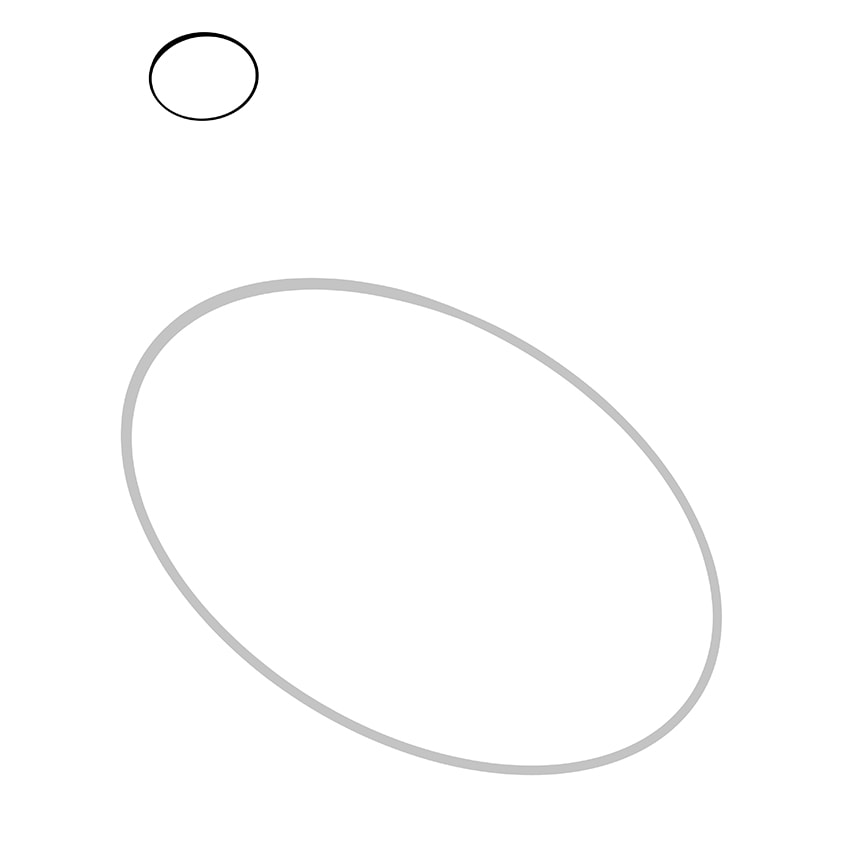
Step 3: Planning the Beak
Before we draw in the neck, let us finish off the chicken's head, beginning by adding the base shape for the beak. On the left side of the head oval, draw a slightly curved "V" shape. Make sure that the beak is the right size, it will look strange if it is not correctly proportioned.
To create as much realism as possible in your hen drawing, the beak should have a downwards curve on the top half and a straighter line on the bottom half.
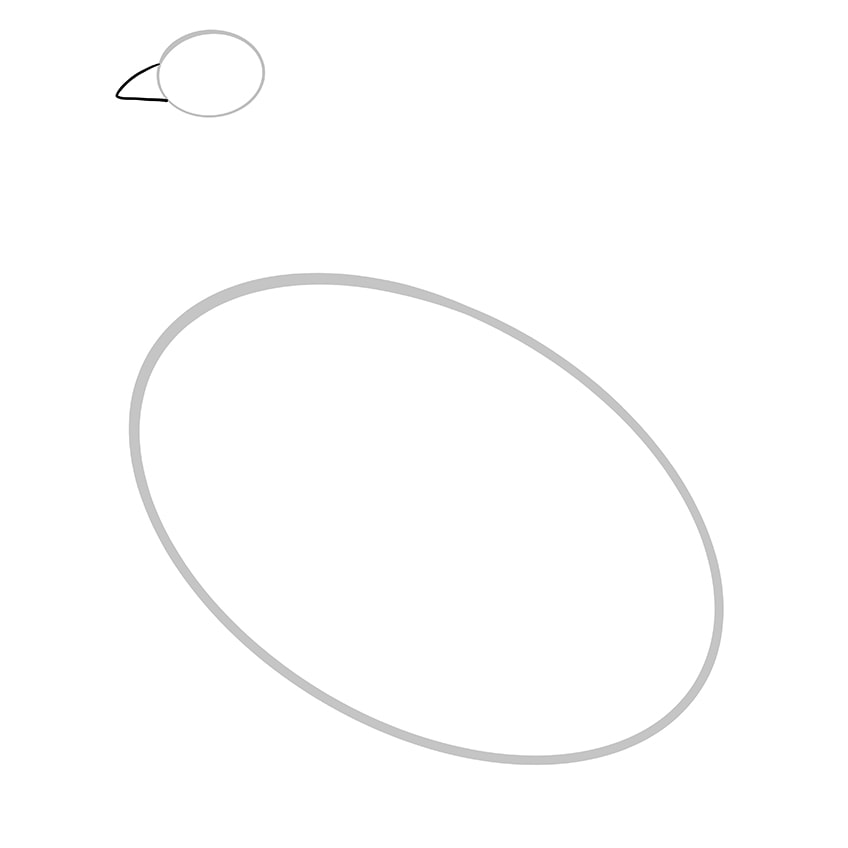
Step 4: Creating the Wattle and Comb
The last detail to lay down for the head of your hen drawing is the wattle and comb. Begin drawing the comb at the top point of the beak and end it with an inward curve on top of the chicken's head. For the wattle, draw a little uneven circle from the base of the beak to the bottom of the head.
These red fleshy parts of the chicken's face are characteristic and the shape of them will determine whether you are drawing a rooster or creating a hen drawing. Because we are drawing a hen, the comb on the top of the head is small.

Step 5: Attaching the Head to the Body with the Necklines
In this step, we are going to use two lines to create the chicken's neck and join the head to the body. Begin drawing the neck with the front line, starting at the end of the wattle and end it along the curve of the main body oval. For the rear neckline, draw a similarly curved line from just behind the end of the comb to the top of the main body oval.
Once you have completed this step, you should be able to see the final shape of your chicken drawing coming together slowly.
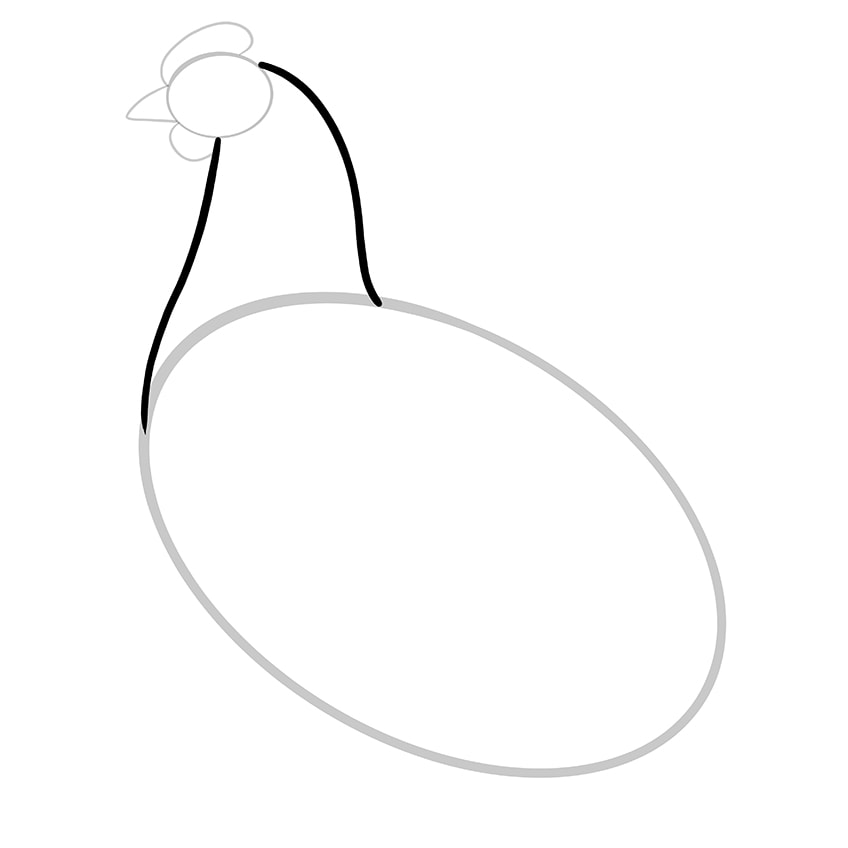
Step 6: Outlining the Shape of the Chicken's Tail
Step six is quick and easy. To create the shape of the chicken's tail, use a more freehand curve that mimics the top fin of a shark. Starting on the top of the main body, a little below the neckline, draw a line that extends out towards the back of the canvas, then turns upward, and finally curves around and down to meet the main body oval again.

Step 7: Constructing the Legs and Feet
In our final construction step, we are going to use single lines to create the basic shape of the chicken's legs and feet. Beginning on the underside of the main body oval, draw a fairly short line that extends straight down. At the end of this line, add four slightly curved toes. Three of these toes should point forwards and one should extend backward.
For the second leg, repeat these same steps, but make this front leg slightly longer and a little more angled towards the front.

Step 8: Drawing the Final Outline of Your Chicken Sketch
Now that we have done all the slightly boring work of construction lines, it is time to put them to work and create the final outline of your chicken drawing. You will see how easy these construction shapes make your life when creating a drawing of a chicken.
We begin at the head, using the construction lines to outline the top of the head, the beak, and the wattle below the head. For the comb, do not follow the construction line too closely, adding in the characteristic curved flaps. You also want to bring the comb down onto the top of the beak further than the construction lines. You can now add some other details to the chicken's facial features, including a separation line on the beak and a nostril. Finally, draw a circle just behind the beak to create the chicken's eye.
Within this circle, add three smaller concentric circles, and use small lines to create a shape around the eye.
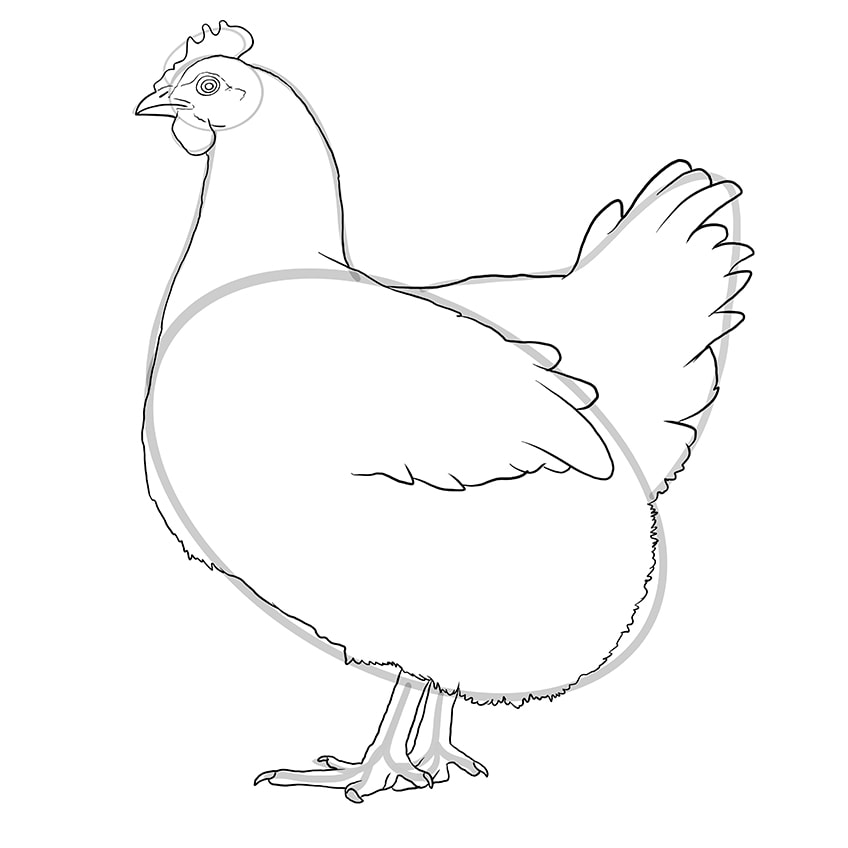
For the rest of the chicken's body, you can follow the construction lines quite closely. Chickens are not smooth and perfectly shaped, however, so you can use slightly scribbly lines throughout your outline to change the shape subtly and add texture.
For the chicken's tail, do not create a smooth line. Instead, create feather streaks, some of which are more rounded, pointy, and square. As you get towards the bottom of the tail, these feather streaks can become smaller.
Using the same feathery shapes, create a wing within the main body oval of your chicken sketch. Finally, use a smooth line to outline the legs and feet equally on either side of the construction lines and add small curved claws on the tips of each toe.
When you are happy with your final outline, you can erase all of your construction lines.
Step 9: Creating Realistic Feathers and Details
Most of the hard work is done, and we have the final outline of our chicken drawing. It is now time to begin adding feathers and other textural details.
Let us start at the head again. Using small dots and short lines, add texture and a touch of shading around the split in the beak, and up around the base of the comb. Use these same light and small textural marks to create details around the chicken's head, and as you begin to move down the neck your lines can get longer and thicker.
When it comes to creating realistic feather detailing, it is best to use the curves of the body to dictate the direction of your little lines.

When you reach the base of the chicken's neck, you can start to use little "U" shaped curves to create a larger feathery texture. Beginning from the chicken's chest, these little curves should get progressively larger as you move towards the tail. You can also start to add short lines of texture to these larger feathers.
For the greatest realism, draw a single line of feathers at a time. This technique will create the layered effect you are looking for.
Finally, add scale details to the chicken's legs and feet. Using a connected line pattern of ovals straight down the front of the legs. For the feet, add a row of little lines across the top of each toe.
Step 10: Painting the First Layer of Color
Although we could say broadly that our drawing of a chicken is brown, there is a great variety of different shades within the feathers. In order to capture this realistic coloring, we are going to build up the colors gradually. Begin with a light orangey-brown shade, and fill the entire body of your chicken sketch.
You want this base coat to be even and quite light as we will be adding shadows and highlights in the next few steps.

Step 11: Time for a Second Coat
For this second coloring step, you are going to need a slightly darker brown. Using this color, add some depth and dimension to the shape of your chicken drawing. Begin at the head, blending a touch of this darker color around the top of the eye and down the neck. Leave the very front of the chest lighter, but surround it with the darker shade. Continue to blend this darker shade on the back above the wing line, below the wing, and behind it, to make it stand out. You can also add patches of this darker color throughout the wings and around the bottom of the belly.
While you want to add a darker color, try to keep this coat as light and fluid as possible. You want a seamless blend from one shade to the next.

Step 12: Blending and Shading
For step 12, choose a golden orange shade and find a light black. Before we start adding a shadow, use a soft brush to add gentle patches of golden brown and orange. Blend these colors together very lightly. Then, take a very soft and small brush and a touch of black paint. Add a shadow contour around the body of the chicken.
Focus this black very lightly on the areas that would naturally be in shadow, around the bottom of the wing, along the chest, around the belly, and on the tail.
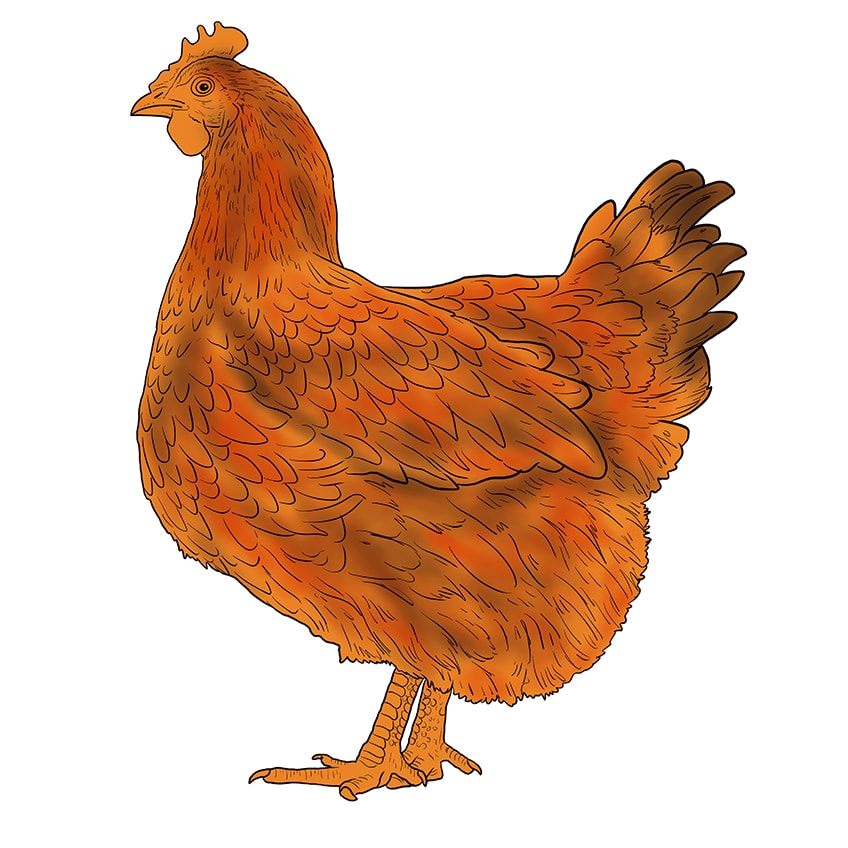
Step 13: Highlighting Your Chicken Sketch
So far, most of our colors have been fairly dark. It is now time to lighten things up a little with a highlight shade. Choose a light caramel color, or a light beige or yellow. As we added shadows where they would naturally fall, we are going to add highlights to the areas of the chicken's body that would naturally catch the light.
Focus the highlights around the top of the back and tail, around the top of the wing, on the very tip of the wing, on the front of the chest, and around the bottom and back of the chicken.
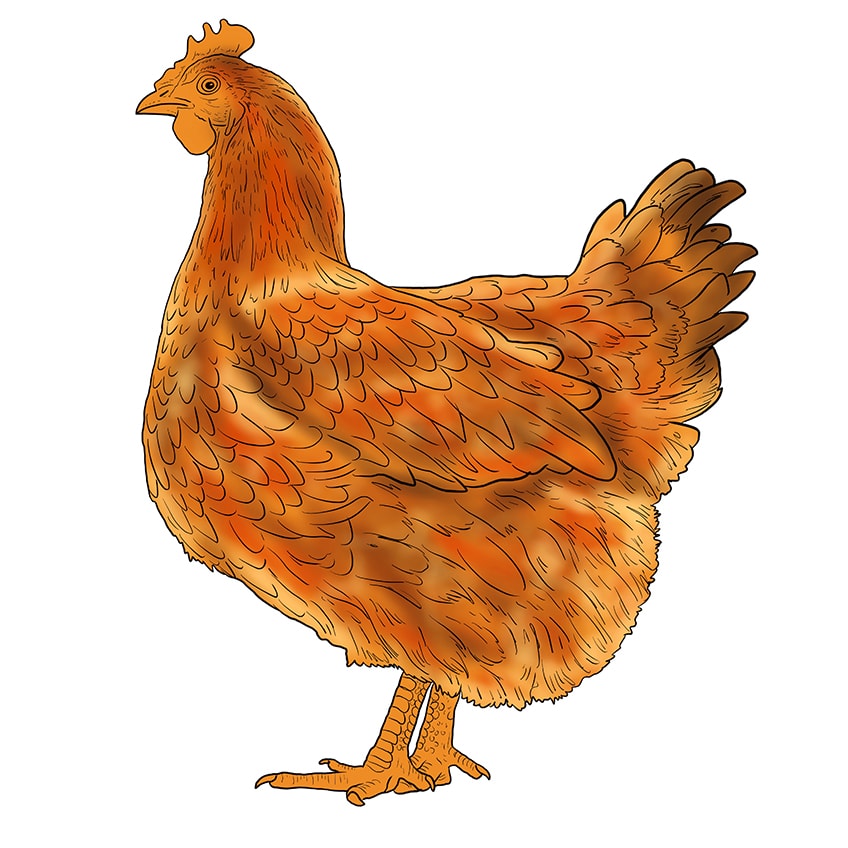
Step 14: Adding Color to the Wattle and Comb
In this second last step, you are going to use a shade of light red to add coloring to the face of your chicken drawing. Color the wattle and comb with this light red shade, and use the same color to add shading around the eye and the base of the beak. You can also add a touch of red to the very back corner of the chicken's face. Apply a second coat of a slightly darker red shade to strengthen the color in the lower parts of the comb.
Finally, finish the face by using a touch of white paint to fade out the red towards the edges of the wattle and comb.
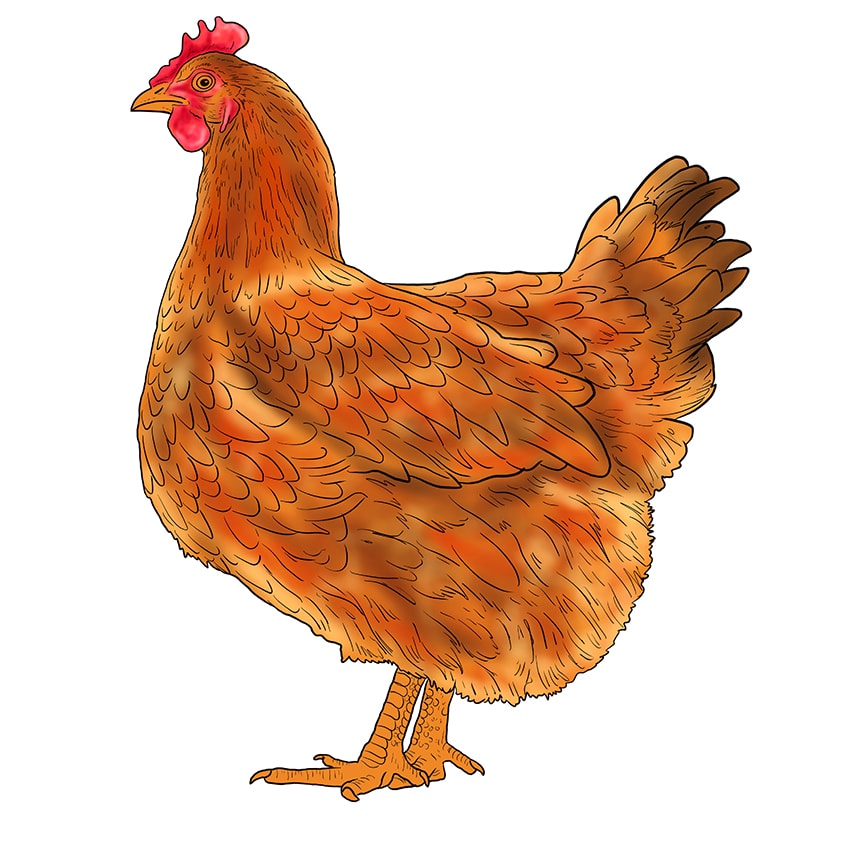
Step 15: Finishing Your Drawing of a Chicken
We are now going to finish our drawing by adding a touch of yellow highlight to the face and feet of your chicken. Using a delicate brush and your lightest highlight shade, add a touch of highlight to the eye, along the top and bottom of the beak, and along the front of the legs and the tops of each toe.

At last, it is time to step back and admire your work. You have successfully created a beautiful and realistic drawing of a chicken in 15 easy steps. We hope that you are happy with your final drawing, and hope to see you soon with one of our other animal drawing tutorials!
Frequently Asked Questions
How do You Make a Drawing of a Chicken Realistic?
There are many different aspects to creating a realistic chicken drawing, including feather details and coloring. It is also essential to nail the perspective and proportions of your hen drawing, and we show you exactly how to do that in our easy chicken drawing tutorial!
How to Draw a Chicken with Different Colors?
The basic shape and details of almost every type of chicken are very similar. Where they tend to diverge is on their coloring, and you have a great deal of freedom to choose the colors for your chicken sketch. You can make your chicken white, black, or even green!
Source: https://artincontext.org/how-to-draw-a-chicken/
0 Response to "How to Draw a Chicken How to Draw a Chicken Easy"
Post a Comment